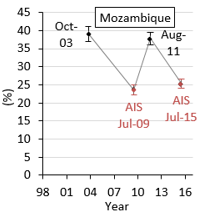| Mozambique differences AIS and DHS [message #14410] |
Wed, 04 April 2018 10:17  |
 Robin
Robin
Messages: 2
Registered: April 2018
|
Member |
|
|
Hello everyone,
I'm analysing data sexual behaviour in eastern and southern Africa, using both DHS and AIS data. In Mozambique, there was an AIS in 2009, a DHS in 2011, and an AIS in 2015. I noticed that for some variables the values differ markedly between these surveys - too much to be 'real'. See the example below for reported multiple partnerships among males. I mainly found these extreme differences for multiple partnerships and types of partners (high-risk/casual) for males, but not among females and in other countries where there are both DHS and AIS.
The reports on the surveys in Mozambique give slightly different values than I have (due to slight differences in calculations) but similarly large differences between 2009, 2011, and 2015. While both AIS and DHS aim to be nationally representative and sample sizes for men are actually comparable here, can these differences be attributable to different sampling methodologies? I don't think there are differences in the questionnaire that can explain this. Or am I missing something?
Would be great to hear if someone has an explanation for this!
Thanks,
Robin
Males reporting multiple partnerships in Mozambique:

|
|
|
|